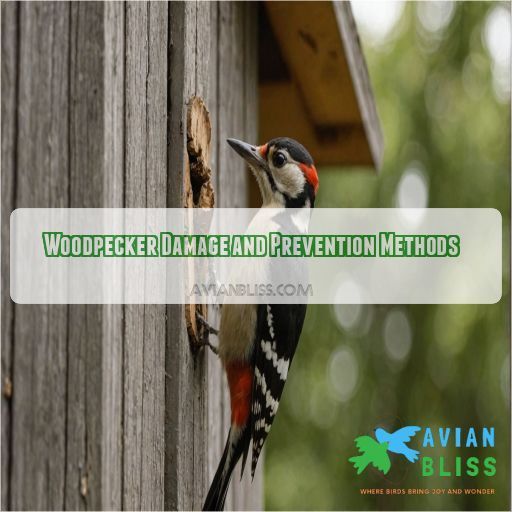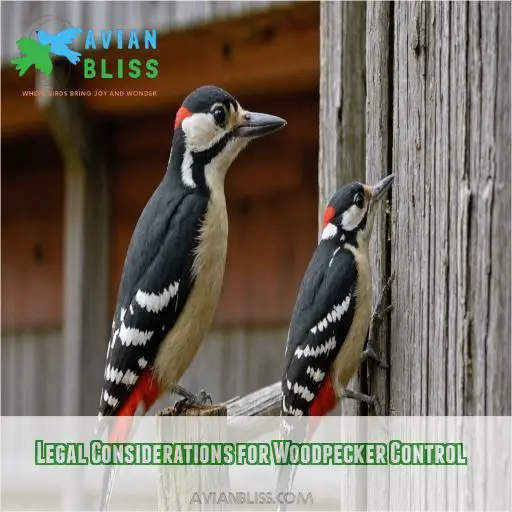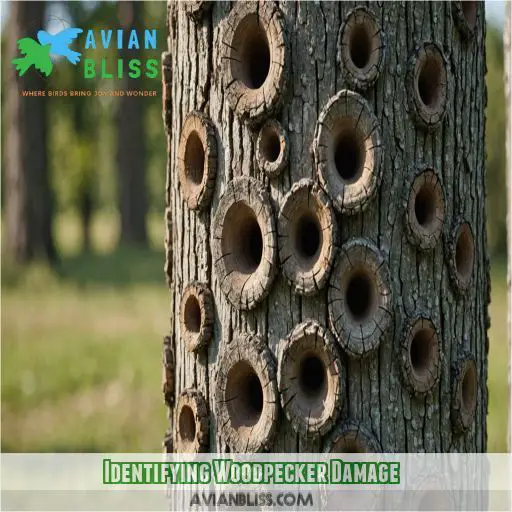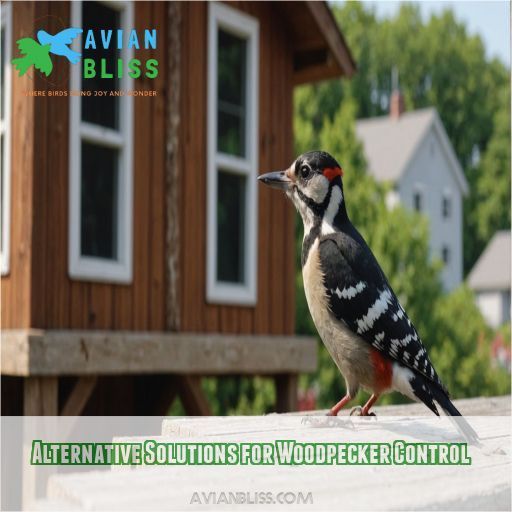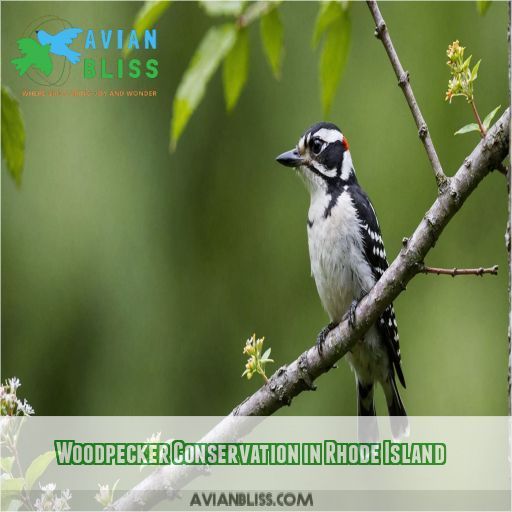This site is supported by our readers. We may earn a commission, at no cost to you, if you purchase through links.
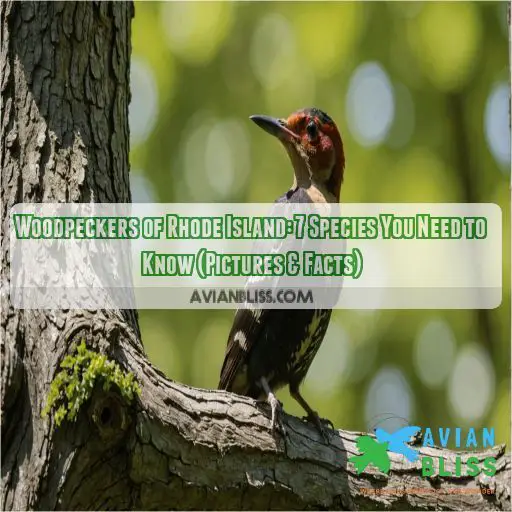
Home to seven striking species, the Ocean State boasts a diverse range of these charismatic birds.
From the tiny Downy Woodpecker to the majestic Pileated Woodpecker, each species has its unique characteristics, habits, and habitats.
You’ll discover the intriguing behaviors of these woodpeckers, from drumming and drilling to foraging and flocking.
But beware: these birds can also cause damage to your home.
Don’t worry, we’ll help you figure out how to prevent woodpecker damage and coexist with these amazing birds.
The woodpeckers of Rhode Island are waiting to be explored!
Table Of Contents
- Key Takeaways
- Woodpecker Species in Rhode Island
- Woodpecker Damage and Prevention Methods
- Legal Considerations for Woodpecker Control
- Identifying Woodpecker Damage
- Woodpecker Behavior and Habitat
- Alternative Solutions for Woodpecker Control
- Preventing Woodpecker Damage in Rhode Island
- Woodpecker Conservation in Rhode Island
- Managing Woodpeckers in Residential Areas
- Frequently Asked Questions (FAQs)
- Conclusion
Key Takeaways
- You’ll want to get familiar with the seven woodpecker species in Rhode Island, each with its unique characteristics, habits, and habitats – from the tiny Downy Woodpecker to the majestic Pileated Woodpecker.
- To peacefully coexist with these birds and prevent woodpecker damage, you’ll need to take steps such as removing attractants, repairing damage with metal or plastic sheathing, using shiny objects to frighten them, and installing lightweight bird netting.
- Don’t even think about harming these birds – they’re protected under the Migratory Bird Treaty Act of 1918, and you’ll need to consider local regulations and permits before taking any action.
- By understanding woodpecker behavior and habitat preferences, you can take steps to prevent damage and create a woodpecker-friendly environment in your yard – such as using bird-friendly building materials, creating a woodpecker-friendly habitat, and dealing with the occasional noise and mess.
Woodpecker Species in Rhode Island
You’re about to meet the fascinating woodpeckers of Rhode Island, with their unique characteristics, habitats, and behaviors that set them apart from one another. From the tiny Downy Woodpecker to the majestic Pileated Woodpecker, you’ll discover the distinct features of each of the seven species that call Rhode Island home.
Downy Woodpecker Characteristics
Meet the Downy Woodpecker, Rhode Island’s smallest woodpecker species! Reaching just 6-7 inches in length, these birds have a distinctive black and white striped back and a tiny beak.
Hairy Woodpecker Identification
You’re familiar with the Downy Woodpecker, but meet its larger lookalike, the Hairy Woodpecker, distinguished by its longer bill and greater size, often found in mature forests and backyards.
Northern Flicker Habitat
You’re likely to spot a Northern Flicker foraging for ants and beetles on forest floors or visiting backyard feeders in Rhode Island, where they’re common visitors .
Pileated Woodpecker Size
You’ll be amazed by the Pileated woodpecker’s size: 16-19 inches long, with a 26-30 inch wingspan, and weighing 8-12 ounces, making it the largest woodpecker in North America.
Red-bellied Woodpecker Diet
In the case of the Red-bellied Woodpecker diet, you’ll find they love:
- Fresh fruits like berries and cherries
- Nuts, especially acorns and hazelnuts
- Insects, such as juicy beetles and ants
Yellow-shafted Northern Flicker Behavior
As you learn about the Red-bellied Woodpecker’s diet, let’s explore the Yellow-shafted Northern Flicker’s behavior, including its unique mating habits, ground foraging strategies, and distinctive "wicka-wicka-wicka" call pattern.
Red-headed Woodpecker Migration
As you learn about the Yellow-shafted Northern Flicker’s behavior, you might wonder about the Red-headed Woodpecker‘s migration patterns, which are influenced by habitat destruction, weather, and breeding seasons.
- Red-headed Woodpecker Migration Patterns:
- Habitat Destruction Impact: Changes in forest composition and structure affect their migration routes and stopover sites.
- Migration Route Changes: Shifts in food availability and weather patterns alter their migratory paths.
- Breeding Season Patterns: Typically breeds in late spring, with males engaging in loud drumming to establish territories.
- Weather Effect Studies: Research suggests that weather conditions, like temperature and precipitation, impact their migration timing and duration.
Woodpecker Damage and Prevention Methods
You’ve learned about the fascinating woodpeckers of Rhode Island, but now it’s time to tackle the not-so-fascinating part: dealing with the damage they can cause.
You want to know how to peacefully coexist with these birds and protect your property from their occasional destructive behavior. By understanding the simple and effective methods for preventing woodpecker damage, you can peacefully coexist with these amazing birds while safeguarding your house and outdoor spaces.
We’ve got you covered with some simple prevention methods.
Removing Attractants Like Bird Feeders
Ready to woodpecker-proof your yard? Start by removing attractants like bird feeders, suet, and sunflower seeds. Try bird feeder alternatives like safflower seeds or hummingbird-friendly flowers. By taking away the welcome mat, you’ll discourage woodpeckers from making themselves at home.
Repairing Damage With Metal or Plastic Sheathing
You’re dealing with woodpecker damage! Don’t worry, repairing it with metal or plastic sheathing is a cost-effective solution. Here are three DIY repair methods to try:
- Assess the damage and choose a matching sheathing material.
- Install metal sheathing for a durable fix.
- Use plastic sheathing for a budget-friendly option.
Using Shiny Objects to Frighten Woodpeckers
Now that you’ve repaired the damage, it’s time to get creative with shiny scare tactics! Use reflective tape, balloons, or CDs to create moving objects that will startle woodpeckers. These bird deterrents are easy to install and surprisingly effective.
Installing Lightweight Bird Netting
Now that you’ve tried shiny objects to scare woodpeckers away, it’s time to bring out the big guns – lightweight bird netting! Install netting with openings of 1 inch or less, at least 3 inches away from the damaged area, to effectively keep those pesky woodpeckers out.
Covering Damaged Areas With Siding
If you’re looking to cover damaged areas with siding, you’ve got options! Consider the following:
- Aluminum siding for a durable, low-maintenance fix
- Vinyl siding for a cost-effective, DIY-friendly solution
- Wood siding for a natural, rustic look
- Fiber cement siding for a fire-resistant, long-lasting option
- Stucco siding for a unique, textured finish
Legal Considerations for Woodpecker Control
As you deal with woodpecker damage, you should keep in mind the legal implications of controlling these birds. Before taking any action, you’ll want to familiarize yourself with the Migratory Bird Treaty Act of 1918 and local regulations, which may require permits for removing protected birds or nests, and consult with wildlife management agencies for expert guidance.
Migratory Bird Treaty Act of 1918
You’re learning how to prevent woodpecker damage, but have you considered the law? The Migratory Bird Treaty Act of 1918 protects woodpeckers and their habitats. Before taking control measures, make sure you have the necessary permits. Here’s a summary:
| Protected Activities | Required Permits |
|---|---|
| Removing nests | Federal permit |
| Killing or harming birds | State and federal |
| Habitat destruction | Environmental permit |
Local Ordinances and Regulations
When dealing with woodpeckers, you must consider local ordinances and regulations. Here are 4 key things to keep in mind:
- Familiarize yourself with local noise limits to avoid fines
- Check if trapping is allowed in your area
- Research required permits for wildlife control
- Understand local laws regarding protected bird species
Permits for Removing Protected Birds
To remove protected birds, you’ll need a permit from a local wildlife agency. Don’t assume you can handle the situation yourself – it’s a legality issue. Exceptions exist, but regulations are strict. Research and understand the specific permits required for your area to avoid harming woodpeckers or facing fines.
Consulting Wildlife Management Agencies
So, you’re dealing with woodpecker damage and wondering what to do? Consult with local wildlife management agencies for expert advice on control methods, permits, and regulations. They’ll guide you through the process, ensuring you handle the situation ethically and effectively, while also connecting you with local agency contacts.
Identifying Woodpecker Damage
Woodpeckers can cause damage to your home in two main ways: drumming and drilling.
Look for signs of these activities, such as holes or dents in your wood exteriors.
Woodpeckers are most active in the fall and spring, so be extra vigilant during these seasons.
If you find signs of woodpecker damage, you’ll want to employ some prevention strategies to keep them away.
Drumming and Drilling Behaviors
As you try to identify woodpecker damage, listen for drumming and drilling behaviors.
These sounds are like a woodpecker’s calling card.
Drumming is a loud, repetitive sound used for territorial defense and attracting mates.
Drilling, on the other hand, is a slower, more deliberate sound used for nest creation and foraging.
These sounds can help you pinpoint the type of woodpecker and its motivations.
Types of Woodpecker Damage
Ever wondered what types of damage woodpeckers can cause? Let’s take a closer look! Woodpeckers can inflict various types of damage, including:
- Siding damage: woodpeckers can drill holes in siding, especially if it’s made of wood or has a wood-like appearance.
- Tree damage: woodpeckers can cause structural damage to trees, especially if they’re already weakened or dead.
- Woodpecker holes: these can lead to water damage, mold, and more if left unchecked.
Common Areas for Woodpecker Damage
Now that you know the types of woodpecker damage, let’s talk about where to look for it.
Common areas for woodpecker damage include:
Woodpecker Behavior and Habitat
Now that you know about the different species of woodpeckers in Rhode Island, let’s take a closer look at their behavior and habitat preferences. From foraging for food to nesting and roosting, you’ll learn about the daily lives of these fascinating birds.
Foraging for Food on Trees
You’re now familiar with identifying woodpecker damage, let’s talk about their foraging habits. Woodpeckers in Rhode Island forage for food on various tree types, each with its unique insect offerings. Here are some interesting facts about their foraging habits:
- Downy Woodpeckers prefer trees with aphid colonies .
- Hairy Woodpeckers tend to forage on larger trees with more abundant insect life .
- Woodpeckers use different foraging techniques, including drumming and probing, to extract insects from tree bark (Source).
- Some woodpeckers, like the Red-bellied Woodpecker, store food in tree cracks and under bark for later use .
Nesting and Roosting Sites
You’re curious about where woodpeckers rest their heads? Nesting and roosting sites are important for these birds. They choose trees with suitable cavities, often using existing holes or excavating new ones. Preferred tree types vary by species, but most favor mature trees with minimal human disturbance. Roosting behavior is often solitary.
Woodpecker Migration Patterns
As you explore the nesting and roosting sites of Rhode Island’s woodpeckers, you might wonder: where do they go when the seasons change? Let’s explore woodpecker migration patterns. Some species, like the Yellow-bellied Sapsucker, migrate to Central America for winter, while others, like the Downy Woodpecker, stay put .
Social Behavior and Flocking
Ever wondered how woodpeckers interact with each other? You’ll be fascinated to learn about their social behavior and flocking patterns.
Woodpeckers establish a social hierarchy, perform elaborate mating rituals, and use drumming to communicate.
They even work together, with some species forming long-term monogamous relationships.
Woodpeckers showcase remarkable group defense strategies. Dominant birds defend their territory from predators.
Alternative Solutions for Woodpecker Control
While the damage woodpeckers cause can be frustrating, it’s important to remember that killing them isn’t the only solution. If you’re facing persistent problems with aggressive or strange woodpecker behavior, there are other responsible control and prevention methods you can explore.
Methods for Killing Problem Woodpeckers
If you’re dealing with problem woodpeckers, you might wonder about "permanent solutions."
However, before we go there, consider the potential backlash: killing woodpeckers can raise serious ethical concerns and even lead to legal ramifications.
Instead, let’s explore humane alternatives that prioritize both human and bird safety.
These include noise-making devices, visual deterrents, and physical barriers – all effective, non-lethal ways to keep woodpeckers at bay.
Dealing With Aggressive Woodpeckers
Dealing with aggressive woodpeckers can be a challenge. Sometimes, these birds become protective of their territory or young, and may even attack people or pets. To address this issue, consider using visual deterrents like shiny reflective tape or balloons to scare them away. If the problem persists, consult with a local wildlife expert to explore humane solutions within legal limits.
Responsible Control and Prevention Advice
When dealing with woodpeckers, you need to think about responsible control and prevention advice. Here are three tips to help you peacefully coexist:
- Remove attractants like bird feeders and suet to discourage woodpeckers from visiting.
- Use humane deterrents like shiny reflective tape or balloons to scare them away.
- Know the legal limits: avoid harming or killing woodpeckers, as they’re protected under the Migratory Bird Treaty Act.
Preventing Woodpecker Damage in Rhode Island
You’re probably keen to learn how to prevent woodpecker damage in Rhode Island, especially if you’ve already fallen in love with these charming birds. By removing dead trees and debris, using noise-making devices, setting up visual deterrents, and installing physical barriers, you can peacefully coexist with Rhode Island’s seven woodpecker species.
Removing Dead Trees and Debris
You’re probably worried about preventing woodpecker damage on your property. Removing dead trees and debris is a great place to start. Dead trees attract woodpeckers, but they also pose safety hazards and decrease property value.
| Reasons to Remove | Benefits |
|---|---|
| Attracts woodpeckers | Reduces damage risk |
| Safety hazards | Prevents accidents |
| Decreases property value | Boosts property value |
| Harbors pests and diseases | Protects surrounding trees |
Using Noise-making Devices
You’ve removed the dead trees and debris, now it’s time to make some noise! Noise-making devices can help deter woodpeckers from your property. Here are four options to think about:
- Air horns: Loud and effective, but may disturb neighbors.
- Electronic bird alarms: Customizable and motion-activated.
- Wind chimes: A more pleasant, non-intrusive option.
- Ultrasonic bird repellers: Silent to humans, but unpleasant for birds.
Visual Deterrents for Woodpeckers
To keep woodpeckers at bay, try using shiny objects to scare them off. Think Scare Eyes or Bird Scare Flash Tape – these DIY deterrents can be super effective. Alternatively, hang some reflective tape or aluminum foil to create a woodpecker-unfriendly zone. Get creative and save your siding!
Physical Barriers for Woodpeckers
To prevent woodpecker damage, try physical barriers like lightweight bird netting or metal sheathing. Cover damaged areas to discourage further pecking. You can also use DIY solutions like installing bird-friendly materials or scare tactics to deter them. Think of it as setting boundaries with your feathered neighbors – gently but firmly.
Woodpecker Conservation in Rhode Island
Woodpecker conservation in Rhode Island is important for preserving these fascinating birds and their habitats. You’ll learn about protecting woodpecker habitats, population trends, community initiatives, and more.
Protecting Woodpecker Habitats
Now, let’s talk about protecting these fascinating birds and their homes. The first step is understanding the challenges they face. Habitat loss is a big issue, especially with urban sprawl eating into their natural spaces.
You can help by supporting conservation efforts that focus on preserving and restoring their habitats. This might include tree planting initiatives or forest management practices that help woodpeckers have the food and shelter they need.
Every little bit helps, and even small changes can make a big difference in making sure these birds continue to thrive in Rhode Island.
Woodpecker Population Trends
Rhode Island‘s woodpecker population has seen some interesting shifts over the years. While the state boasts a healthy human population, let’s explore the dynamics of these feathered residents.
The Red-bellied Woodpecker population has experienced a notable surge in recent decades, earning the title of the most widespread woodpecker species in the state. This increase is linked to the expanding forested land and woodlots across Rhode Island.
On the other hand, the Red-headed Woodpecker population has taken a hit, declining by over 70% in the last 50 years. This unfortunate trend is largely due to habitat loss, specifically the destruction of giant beech forests, which provide their beloved beechnuts.
The Pileated Woodpecker, once scarce in the mid-1980s, has rebounded thanks to the maturation of Rhode Island’s forests. They’re now spotted in locations like Lincoln Woods and Great Swamp.
Conservation Efforts for Woodpeckers
As you’ve learned about Rhode Island’s woodpecker population trends, you might wonder what’s being done to protect these birds. Conservation efforts are underway to address habitat loss and promote sustainable forestry practices . Organizations are also working together to create conservation partnerships and engage citizens in nest box placement initiatives .
Community Involvement in Woodpecker Conservation
Now that you know about conservation efforts for woodpeckers, let’s talk about how you can get involved in your community. Here are three ways to make a difference:
- Join a local citizen science project to monitor woodpecker populations.
- Participate in habitat restoration events to create woodpecker-friendly environments.
- Support education outreach programs to teach others about woodpecker conservation.
Managing Woodpeckers in Residential Areas
As you learn to coexist with woodpeckers in Rhode Island, you’ll want to make your home and yard a welcoming space for these amazing birds while also protecting your property from damage.
You can enjoy the benefits of having these incredible creatures as neighbors by using bird-friendly building materials, creating woodpecker-friendly habitats, and finding ways to deal with the occasional noise and mess.
Using Bird-friendly Building Materials
When building or renovating your home, consider using sustainable siding and eco-friendly building options.
Opt for recycled materials or timber alternatives that are less appealing to woodpeckers.
Choose the right materials to minimize wood damage and create a harmonious coexistence with these amazing birds.
Your home will thank you for the thoughtful design.
Creating Woodpecker-friendly Habitats
Now that you’re using bird-friendly building materials, let’s create a woodpecker-friendly habitat. By incorporating native trees, you’ll attract insect diversity, a woodpecker’s favorite snack. Consider adding:
- Native trees like oak, maple, or pine
- A water source, like a birdbath or pond
- Nesting cavities or dead trees
- A mix of forest and open areas for the best forest health
Dealing With Woodpecker Noise and Mess
Now that you’ve created a woodpecker-friendly habitat, it’s time to address the not-so-glamorous side of woodpecker management: noise and mess. Here are some tips to help you minimize the chaos:
| Noise Reduction | Mess Cleanup |
|---|---|
| Use visual deterrents | Install bird netting |
| Employ noise-making devices | Clean up debris regularly |
| Seal entry points | Use bird-repellent balloons |
Remember to always follow local regulations and consider consulting a wildlife expert if the issue persists.
Coexisting With Woodpeckers in Rhode Island
You’re willing to coexist with woodpeckers in Rhode Island! Now that we’ve tackled the noise and mess, let’s make your yard a woodpecker-friendly haven. Use bird feeder strategies that discourage drumming, and consider adding a woodpecker nesting box. Remember to follow Rhode Island laws and protect their habitats.
Frequently Asked Questions (FAQs)
What attracts woodpeckers to residential areas in Rhode Island?
Like a siren’s call, shiny objects and tasty treats lure woodpeckers to residential areas. You see, they’re drawn to suet, sunflower seeds, and peanuts, so removing these attractants can help prevent unwanted drumming on your home’s exterior.
How can I differentiate between male and female woodpeckers?
You can differentiate between male and female woodpeckers by looking for distinctive markings, such as red spots, stripes, or patches on their heads, backs, or bellies, which vary depending on the species and sex.
What is the typical lifespan of woodpeckers in Rhode Island?
Woodpeckers in Rhode Island have varying lifespans. The Yellow-shafted Northern Flicker can live for over five years, while the lifespan of the Yellow-bellied Sapsucker is said to range from five to nine years.
Can woodpeckers transmit diseases to humans or pets?
Regarding diseases, you can breathe a sigh of relief: woodpeckers aren’t typically known to transmit diseases to humans or pets. Still, it’s always a good idea to exercise caution around birds and their droppings.
Are woodpeckers protected by Rhode Island state laws?
You’re wondering if woodpeckers are protected in Rhode Island. Well, under the Migratory Bird Treaty Act of 1918, many woodpecker species are shielded from harm. Rhode Island state laws also provide additional safeguards, so you should definitely check local regulations.
Conclusion
Now that you’ve met the fascinating woodpeckers of Rhode Island, you’re probably wondering how to peacefully coexist with these charismatic birds.
The key is to understand their unique characteristics, habits, and habitats.
By taking steps to prevent woodpecker damage and respecting their space, you can enjoy the benefits of having these amazing birds around.


